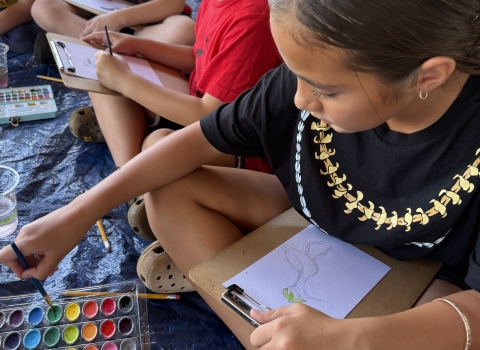An invasive species is any plant or animal that has spread or been introduced into a new area where they are, or could, cause harm to the environment, economy, or human, animal, or plant health. Their unwelcome presence can destroy ecosystems and cost millions of dollars.
Learn more about invasive species (AIS) captured during the Fall 2022 non-native Fish Slam in Broward and Miami-Dade Counties, Florida.
Species pictured above top row left to right- juvenile oscar (Astronotus ocellatus), walking catfish (Clarias batrachus), jaguar guapote (Parachromis managuensis)
Bottom row left to right- Midas cichlid (Amphilophus citrinellus), swamp eel (Monopterus albus), brown hoplo (Hoplosternum littorale)
While it is not rare to encounter a non-native aquatic invasive species (AIS) in South Florida's tropical waterways, one may be surprised to encounter 30+ fish biologists hovered around plastic folding tables, buckets, and coolers full of these non-native AIS in a mall parking lot in South Florida. This is a sight to see, and one you would have encountered if you were shopping near Kendall in South Miami on December 7-8, 2022. “What is that thing?” “I have never seen a fish like that!” and “Do people eat those fish?” were the types of questions shouted by onlookers that could be heard over the buzz of fish biologists sharing thoughts and discussing changes to complicated scientific names. These encounters with the public made for great educational moments where the who, what, when, where, and how of AIS could be explained. And yes, people do eat these fish. We know the thought of eating an exotic fish out of a South Miami canal may not be intriguing to all, but many of these species made it to South Florida because they represent a delicious source of food in their native range. For many reasons like the tropical climate, numerous waterways, and growing populations South Florida is seen as a hotspot for newly introduced and already thriving AIS. This is why the Fall 2022 non-native Fish Chat and Fish Slam was held in Broward and Miami-Dade counties.
Fish Slam? Fish Chat? What’s that? The objective of the bi-annual Nonnative Fish Slam is to conduct early detection surveys in areas of Florida that may potentially have new introductions of exotic aquatic species. While the purpose of the Fish Chat is to create a very informal atmosphere for all agencies involved in AIS management to share what AIS projects they have been working on, issues they are seeing, and allow for open discussions with colleagues with the intent of helping and learning from one another. This cooperative effort, supported with USFWS AIS funds, included over 35 fish biologists in 12 teams with representatives from the Miccosukee Tribe of Indians of Florida, U.S. Fish and Wildlife Service (Peninsular Florida FWCO and Welaka National Fish Hatchery), Florida Fish and Wildlife Conservation Commission (FWC), U.S. National Park Service, U.S. Geological Survey - Nuisance Aquatic Species Section, Florida International University, University of Michigan, University of Florida, Virginia Tech, Frost Museum of Science, and U.S. Army Corps of Engineers. Crews were spread out over Broward and Miami-Dade counties and sampled canals and waterbodies using electrofishing boats, rod and reels, minnow traps, nets, and other types of sampling gear.
Over 14 species of non-native fish and one species of non-native amphibian were captured and documented. One of the exotic fish drew especially loud praise from the crowd, the Midas cichlid (Amphilophus citrinellus). The first part of its common name refers to the color of this orange/gold dipped cichlid that is native to San Juan River and adjacent watersheds in Costa Rica and Nicaragua. While other species, like the lone amphibian captured Caecilians, drew exclamations of a different nature. It may look like a worm or snake, but these long, lithe creatures belong to a group of legless amphibians known as Gymnophiona. With its eyes mostly covered in skin, a mouth full of teeth, and skin that secrets toxins one would understand the exclamations of horror from the public and excited chatter from the biologists. The AIS captured during this event not only filled a database with locations and descriptions, but tissue samples were collected from each species to be used for the development of eDNA [environmental DNA] primers. The eDNA primers will be an additional tool for the detection and management of AIS. Representatives from each species of aquatic animal collected were identified and transferred to the ichthyology collections at the University of Michigan’s Museum of Zoology and the Florida Museum of Natural History.
Species pictured above Top row left to right- Mayan cichlid (Mayaheros urophthalmus), Caecilians, sailfin catfish (Pterygoplichthys multiradiatus)
Bottom row left to right- swamp eel (Monopterus albus) displaying an interesting color pattern, butterfly peacock bass (Cichla ocellaris), oscar (Astronotus ocellatus)



